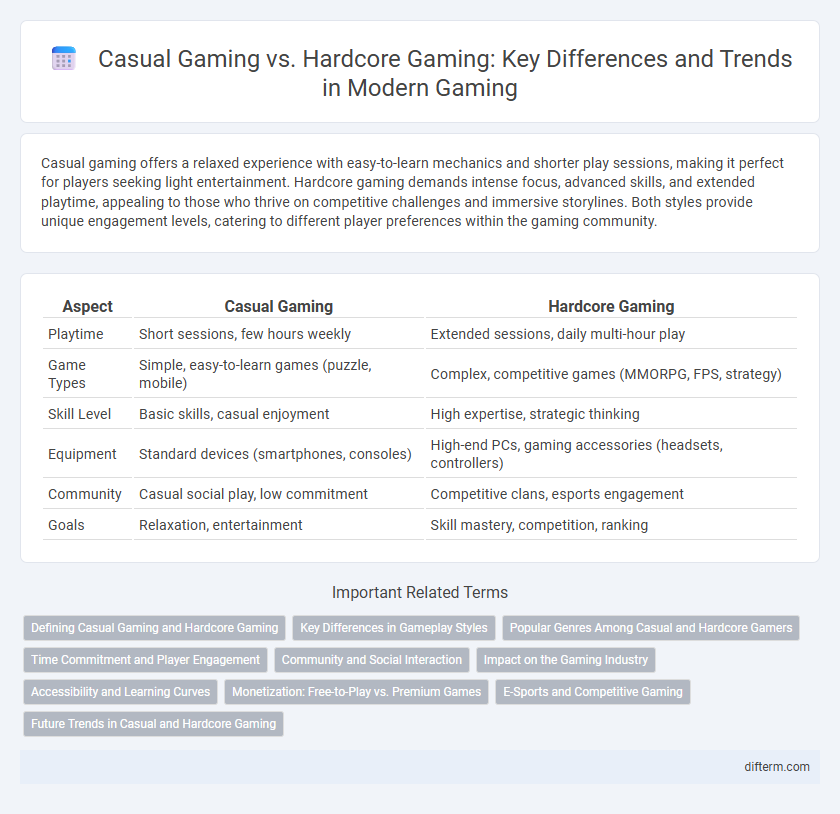Casual gaming offers a relaxed experience with easy-to-learn mechanics and shorter play sessions, making it perfect for players seeking light entertainment. Hardcore gaming demands intense focus, advanced skills, and extended playtime, appealing to those who thrive on competitive challenges and immersive storylines. Both styles provide unique engagement levels, catering to different player preferences within the gaming community.
Table of Comparison
| Aspect | Casual Gaming | Hardcore Gaming |
|---|---|---|
| Playtime | Short sessions, few hours weekly | Extended sessions, daily multi-hour play |
| Game Types | Simple, easy-to-learn games (puzzle, mobile) | Complex, competitive games (MMORPG, FPS, strategy) |
| Skill Level | Basic skills, casual enjoyment | High expertise, strategic thinking |
| Equipment | Standard devices (smartphones, consoles) | High-end PCs, gaming accessories (headsets, controllers) |
| Community | Casual social play, low commitment | Competitive clans, esports engagement |
| Goals | Relaxation, entertainment | Skill mastery, competition, ranking |
Defining Casual Gaming and Hardcore Gaming
Casual gaming involves short, easy-to-learn sessions with simple mechanics, appealing to a broad audience who play for relaxation or passing time. Hardcore gaming demands significant time investment, complex strategies, and deep engagement, often involving competitive or story-driven experiences. Key distinctions hinge on player commitment, game complexity, and intensity of gameplay challenges.
Key Differences in Gameplay Styles
Casual gaming emphasizes simplicity, short play sessions, and accessibility, often featuring easy-to-learn mechanics suitable for a broad audience. Hardcore gaming demands intense focus, complex strategies, and extended playtime, targeting dedicated players seeking challenging experiences. The key differences lie in game complexity, player commitment, and the depth of skill required in each style.
Popular Genres Among Casual and Hardcore Gamers
Casual gamers often gravitate towards puzzle, simulation, and mobile games due to their easy-to-learn mechanics and shorter play sessions. Hardcore gamers prefer genres like first-person shooters, real-time strategy, and massively multiplayer online role-playing games (MMORPGs) that demand intense skill, time investment, and strategic thinking. The popularity of games like Candy Crush for casual players contrasts with titles like Call of Duty and World of Warcraft favored by hardcore audiences.
Time Commitment and Player Engagement
Casual gaming typically requires minimal time commitment, allowing players to engage in short, intermittent sessions without intensive focus, making it ideal for relaxation and quick entertainment. Hardcore gaming demands extensive time investment with players often dedicating multiple hours daily to immersive gameplay, strategic planning, and skill development. Player engagement in hardcore gaming is deep and continuous, driven by complex challenges and competitive environments, whereas casual gaming maintains light engagement through simple mechanics and accessible content.
Community and Social Interaction
Casual gaming fosters a broad, welcoming community where players often engage in lighthearted social interactions and cooperative play, enhancing accessibility and shared enjoyment. Hardcore gaming communities emphasize competitive gameplay, strategic communication, and deep collaboration, creating intense social bonds centered around skill mastery and esports events. Both gaming styles leverage platforms like Discord and Twitch to build dynamic social experiences tailored to varied player preferences.
Impact on the Gaming Industry
Casual gaming drives widespread industry growth by attracting a diverse audience with accessible gameplay and mobile-friendly platforms, leading to increased revenue from microtransactions and ad placements. Hardcore gaming fuels innovation and technological advancements through demand for high-performance hardware, immersive experiences, and competitive esports scenes. The synergy between casual and hardcore segments shapes market trends, content development, and investment priorities across the gaming ecosystem.
Accessibility and Learning Curves
Casual gaming offers high accessibility with simple controls and minimal learning curves, making it easy for players of all ages and skill levels to enjoy quickly. Hardcore gaming often involves complex mechanics and steep learning curves, requiring significant time investment to master and a deeper commitment to gameplay. Accessibility in casual games drives widespread appeal, while hardcore games prioritize depth and challenge for dedicated enthusiasts.
Monetization: Free-to-Play vs. Premium Games
Free-to-play games dominate casual gaming, using microtransactions and in-app purchases to generate revenue without upfront costs, attracting a broad audience. Premium games in hardcore gaming rely on one-time purchases or subscriptions, offering deeper experiences with fewer monetization interruptions. This divergence in monetization strategies reflects the distinct player motivations and engagement levels between casual and hardcore gaming markets.
E-Sports and Competitive Gaming
Casual gaming emphasizes accessible gameplay and relaxed engagement, attracting diverse audiences with simple mechanics and shorter sessions. Hardcore gaming centers on skill-intensive challenges and strategic depth, often overlapping with E-Sports where players compete in structured tournaments for significant recognition and prizes. Competitive gaming demands rigorous practice, advanced techniques, and mental resilience, making it a professional arena distinct from casual play.
Future Trends in Casual and Hardcore Gaming
Future trends in casual gaming emphasize mobile and cloud-based platforms, leveraging AI to personalize game experiences and enhance accessibility. Hardcore gaming is expected to see increased adoption of virtual reality (VR) and augmented reality (AR), enabling immersive gameplay and competitive esports growth. Cross-platform integration and blockchain technology will further blur the lines between casual and hardcore gaming communities.
casual gaming vs hardcore gaming Infographic

 difterm.com
difterm.com